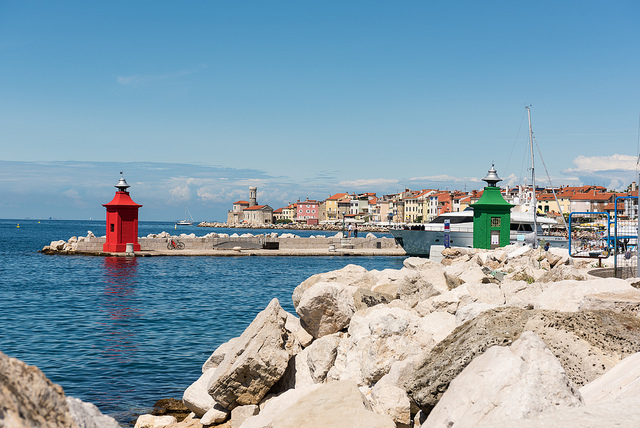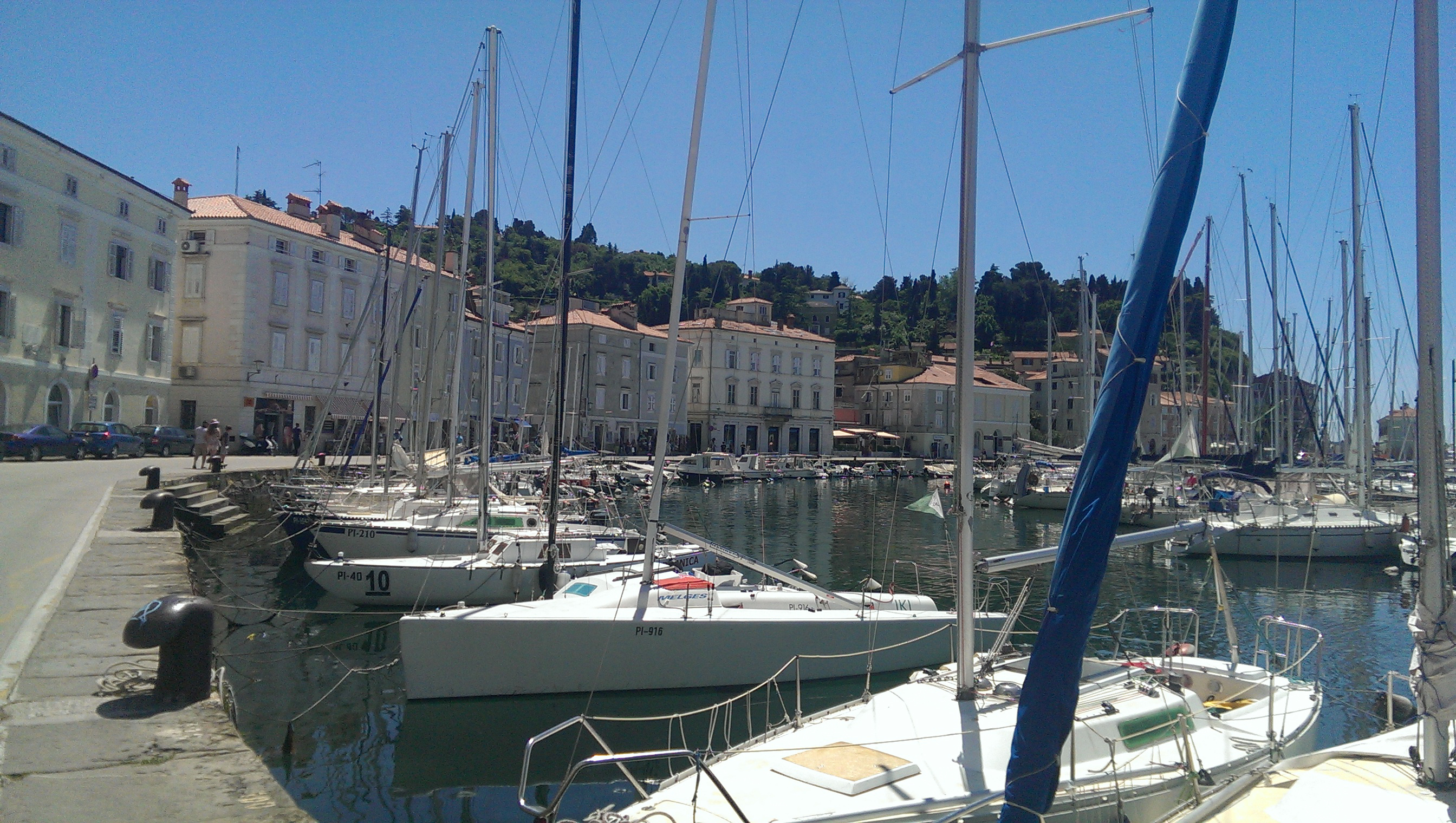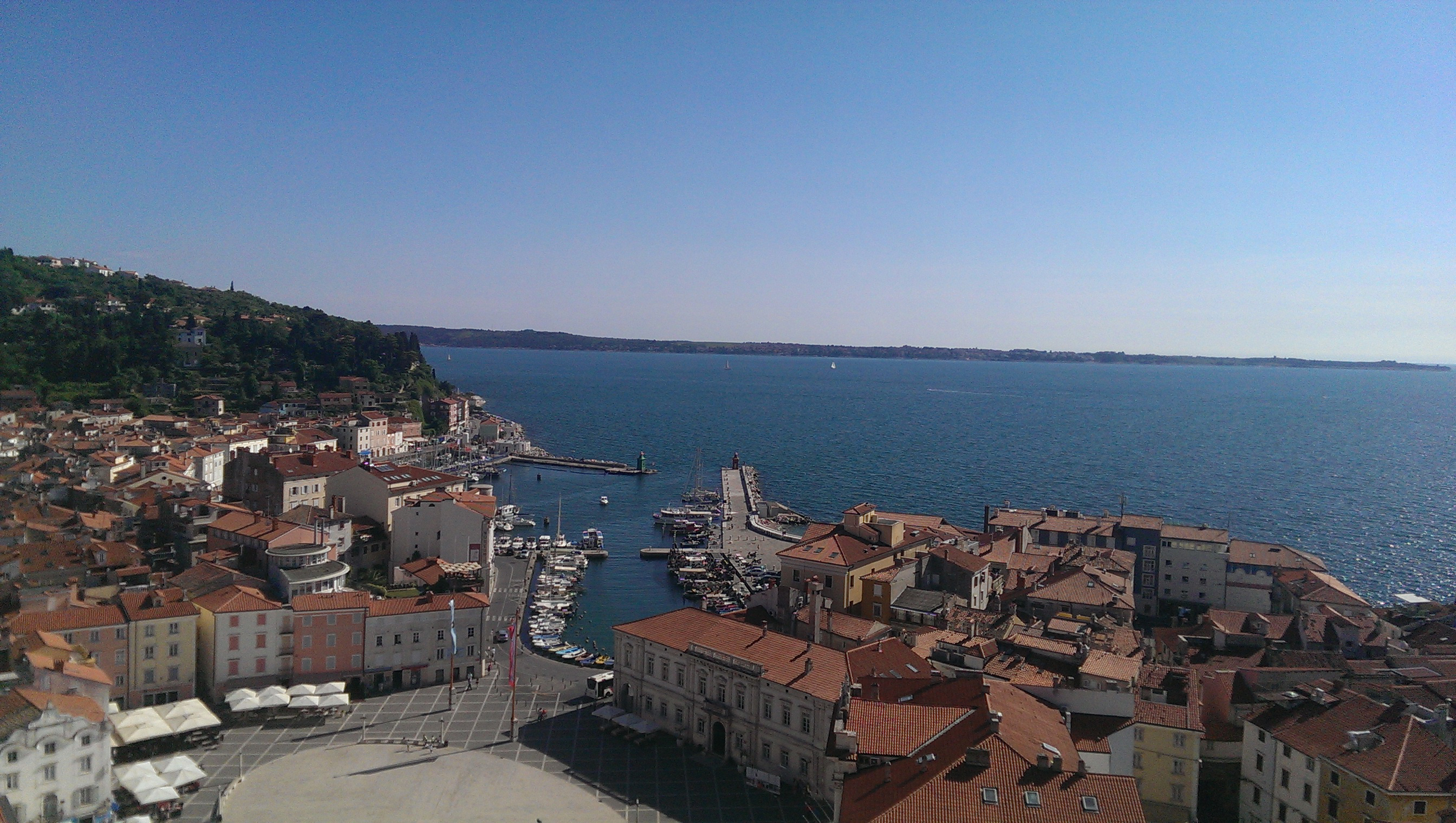Piran pokes out on a peninsula where, to the left, you can see Croatia and, to the right, you can see Italy. The main square is a bleak space edged by frilly pastel buildings and local bars, but head down the winding lanes and there are authentic seafood restaurants, ornate apartment blocks, and tiny artisan shops.

The main square in Piran (Photo: Lizzie Davey)
I found myself in an oval-shaped “square”, the uneven cobbles scrubbed to perfection. Behind me, tiny boats bobbed on the water and fishermen called to each other across the promenade. Ahead, a wall of bright, pastel buildings cowered beneath a looming mountain with an old fortification perched haphazardly on top. Back on ground level, tables and chairs spilled out into the square where punters swigged cool beer in the early afternoon heat.
Blackboards promised delicious pizzas topped with all kinds of fresh veg and meat – Italy, through and through. Only I wasn’t in Italy, though if I backtracked a few steps to the port I could probably see it from where I stood. I was actually in Slovenia, which clutches only a small section of the Adriatic coast – 46 kilometres, to be precise.
Before I found myself standing in the oval square with the sea just moments away, I pictured Slovenia as one big forest. It was supposed to be studded with old lodges tucked away in ancient woods and still lakes sprawling out as smooth as egg shells. It was for hikers and adventure-seekers where, in the winter, snowboarders hit the mighty, snow-covered slopes. It wasn’t a place for sunbathing and sea views.
Except, it was. In the square of old Piran, a town that sits pretty and peacefully right on the edge of the Adriatic, I felt like I was in the heart of the Mediterranean; a place where Baroque Italy meets laid-back Croatia.
Though the main square is the pride and joy of Piran, with its frilly pastel buildings and local bars, if you head down the winding lanes that spider off it, you’ll find plenty of authentic seafood restaurants, ornate apartment blocks, and tiny artisan shops. A harbour lies along the coastline before a lengthy promenade flanked by white rocks, where wrinkly fishermen cast their lines. At the end of the walkway, a carved mermaid looks gallantly out to sea.

A view out over Piran’s Harbour (Photo: Gilles Messian via Flickr)
A Very Venetian Past
The town itself is almost like a cultural monument in its own right, harking back to a history that’s both rich and fascinating. From its early days as a Roman settlement, Piran has managed to retain much of its ancient character and is thought to be one of the best-preserved historical towns on the length of the Adriatic.
It was the 13th century when Piran came into its own, though – an era that is etched on the ornate buildings and perfect pastel paintwork throughout the town. For 500 years, Piran was under Venetian rule, which it supported whole-heartedly (thanks, in part, to Venice’s booming salt industry that towered over Piran’s fledgling forays into the salt world). During this time, Piran blossomed into a picturesque town, with grand new buildings popping up and many of its looming fortifications coming to life.
Later, in the 19th century, it stagnated under Austrian and Italian rule. While this may have seemed like a step backwards from its fruitful days under Venetian rule, it actually meant the town kept its medieval charm, which it still emanates today.
Piran’s turbulent past is echoed in this sentiment, being pulled from one culture to another – not helped, I’m sure, by its close proximity to both Croatia and Italy. However, this has some benefits. In some ways, Piran is almost like its own country, combining the friendly, laid-back nature of Slovenia, the delicious food of Italy, and the lively personality of Croatia. But though Piran is wedged firmly between the clutches of its neighbours, it still manages to sing to a tune of its own, which is made evident in its collection of arts and cultural attractions pulled from its many different narratives; the Tartini House, the Town Hall and the Court Palace touch on the town’s Venetian past, while the Maritime Museum and the Salt Works Museum showcase its old working life.
In my effort to take in the charm of Piran through every pore, I found a restaurant that jutted right out into the sea and ordered a freshly-caught sea bass – seafood is a prominent part of life in Piran thanks to its quaint harbour, with practically every eatery promising fresh clams, fish, prawns, and every sea creature in between.
To my surprise, the chef himself came out to de-bone the sea bass right in front of my eyes; right in front of the sea where, probably just that morning, the fish had been flapping about minding its own business. Afterwards, a smiling waiter promptly served me a shot of local grappa “on the house”, a strong spirit made from homegrown grapes. Later, I found out he’d made it himself, pouring it from a glass bottle that might have once held ketchup or mustard. It was this unmistakable hospitality that really warmed me to Piran, where baristas laughed with customers sipping rich espressos and shopkeepers took a genuine interest in how their client’s days were going.
Though it’s tucked away between two popular lands (both of which it’s often overlooked for), strolling through Piran is like taking a wander through another world entirely. Breathing in the fresh scent of sea salt and home-cooked food, and taking in the decorative buildings and statues, I realized this was a corner of the Med that I wanted to remember. It’s amazing how something you didn’t know existed can suddenly become one of your favourite places on the planet. That’s the magic of Piran.

